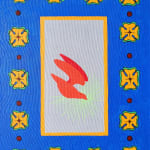Open a larger version of the following image in a popup:
 Photo by Laurynas Skeisgiela
Photo by Laurynas Skeisgiela
 Photo by Laurynas Skeisgiela
Photo by Laurynas Skeisgiela
Open a larger version of the following image in a popup:
 Photo by Laurynas Skeisgiela
Photo by Laurynas Skeisgiela
 Photo by Laurynas Skeisgiela
Photo by Laurynas Skeisgiela
Monika Radžiūnaitė Lithuanian, b. 1992
Karvelis - Šventoji Dvasia, nors vanagui tik mėsa / Sus est Spiritus Sanctus, licet accipiter tantum escam / Kiaulė yra Šventoji Dvasia, nors vanagas yra tik mėsa // A dove is the Holy Ghost albeit only a prey for a hawk / Sus est Spiritus Sanctus, licet, 2023
Aliejus ant drobės / Oil on canvas
24 x 18 x 2 cm
Further images
Monika Radžiūnaitė (b. 1992, Lithuania) is a painter who obtained MA degree at the Vilnius Academy of Arts in 2021, Painting Department. Her work is characterised by interpreting history, reviving...
Monika Radžiūnaitė (b. 1992, Lithuania) is a painter who obtained MA degree at the Vilnius Academy of Arts in 2021, Painting Department. Her work is characterised by interpreting history, reviving elements of medieval and early renaissance paintings, and using cultural references in painting plots.
In her paintings, Radžiūnaitė talks about foolishness and the change in cultural meanings over the course of history. Her works are based on ignorance, foolishness, and/or error. This creative strategy as a conscious state of foolishness frees the artist from the need to know the true or historical meanings of the images or the circumstances of their formation. Radžiūnaitė raises questions about the possibility of reconstructing the Middle Ages and the limitations of such possibility determined by historical circumstances. Past, present, and future are difficult to measure and understand objectively, while cultural continuity and the influence of past epochs on contemporaneity can be deconstructed ironically.
In her paintings, Radžiūnaitė talks about foolishness and the change in cultural meanings over the course of history. Her works are based on ignorance, foolishness, and/or error. This creative strategy as a conscious state of foolishness frees the artist from the need to know the true or historical meanings of the images or the circumstances of their formation. Radžiūnaitė raises questions about the possibility of reconstructing the Middle Ages and the limitations of such possibility determined by historical circumstances. Past, present, and future are difficult to measure and understand objectively, while cultural continuity and the influence of past epochs on contemporaneity can be deconstructed ironically.








